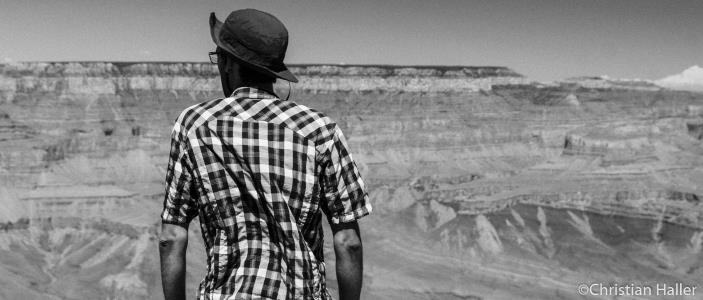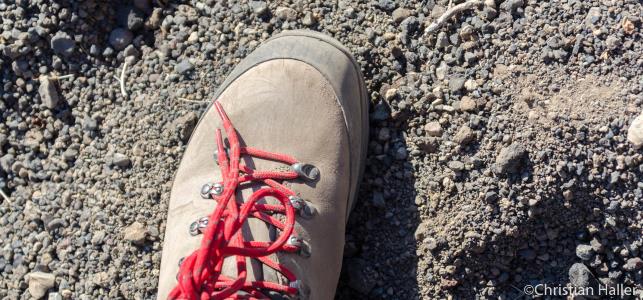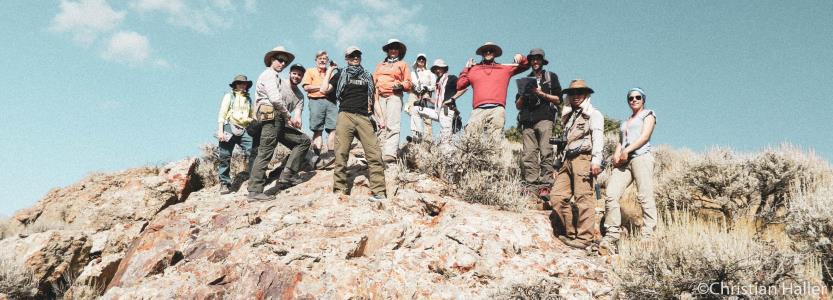Academic Interests
Plans for future academic research endeavors and engagement in Geoscience.

Work @ USGS St. Petersburg Coastal and Marine Science Center
Statement of Research (Geoscience)
Overview of the field
Shelf and coastal regions are the front lines in societal challenges of climate change, environmental policy, and resource exploration and management. For geological research they play an important role as geologic records of paleo-climate, past sea-level, accumulation of economic resources, and deposits of erosional products of mountain ranges. Even though such marginal marine environments, from coast to shelf edge, have the potential to comprise strongly expanded sections with substantial interest for study, there are still many blank spots on the geologic map. The difficulty or inability to obtain complete, and undisturbed records from offshore regions looms as a large obstacle to (marine) geologists. While estuarine environments can be sampled with smaller budgets, water depth typically scales with costliness, but also length of the records obtainable. High-resolution sections can be found in delta regions with intense basin subsidence from siliciclastic input and in the carbonate-depositional regions of the world. Basin Modeling is the discipline for unifying information sourced from other sub-disciplines for reconstruction of events in a sediment sink area, taking inputs from many sub-disciplines on various scales that have to be interpreted in context of each other. A few of these are the following:
Microfossil-related proxy data is used to make inferences about age of strata (biostratigraphy) and also paleobathymetric and paleoenvironmental estimates that are both directly required for burial history models. Basins and intra-basin sites can be mineralogically and elementally fingerprinted and compared with one another through geochemical proxy records (e.g., stable isotopes, elemental composition) measured from fossil skeletal material and bulk sediment. The proxy information is also used in a broader context to unravel paleoclimatic conditions, water temperature, salinity, and other parameters. Seismic surveys are useful to visualize large-scale and low-resolution distribution of subsurface formations (or more so impedance differences). However, most what is known today is based on parameterizations, assumptions and lateral extrapolation. Unfortunately, these assumptions are known to be a significant source of errors in many basin models, especially if they are not in areas of commercial interest.
To bring all the disciplines together in a meaningful way, it is inescapable to retrieve geological samples and ground-truth geophysical assumptions in context of modern analogues in contemporary sedimentary research. In my research, I strive to establish a better understanding of the shelf depositional realm and find ways to improve on estimates made in paleoenvironmental and bathymetric aspects in basin models.

Field Trip Instructor @ Grand Canyon National Park, AZ
Past and ongoing work
Reconstructing histories of marginal marine and shelf processes is carried out to inform about future earth and ocean system developments to be expected. A significant portion of my work has dealt with such reconstructions. Employing tools such as age-depth models and microfacies analyses in challenging environments from coastal marine to shelf-edge, from engineering time scales to Neogene age, I, together with my coauthors have studied the siliciclastic and carbonate sedimentary, paleontological, paleoenvironmental, and paleoceanographic properties of such marine sediment records. We have identified strengths and weaknesses of performance of quantitative sea-level reconstructions using intertidal microfossils, i.e., their reliance on very-well assembled modern training sets particularly in regions of low tidal range such as the northern Gulf of Mexico. These findings are of significance to the efforts of improving the model accuracy in low tidal-range marsh regions of the world.
One of my ongoing coastal projects focuses on comparison of sites using multiple cores from different types of estuarine marshes. The project highlights the pitfalls that can be encountered in delta areas of sediment supply re-routing (stream piracy). The goal of this project is to highlight the danger of making false assumptions on secular sediment supply rates in a delta setting that may be unwarranted or idealized. Another widespread shoreline phenomenon is backstepping erosion and reduced minerogenic aggradation rates due to sediment-starvation. Thus, variable sedimentation rates may yield biased sea-level rise rates and de-validate the reconstruction. While previous inter-tidal studies have concentrated on a single sedimentary core without a reference, this project supplies multiple sediment cores from different settings in a region (backbarrier marsh vs. mainland marsh/delta) that highlight variability and bias. The project has already yielded meaningful constraints and is currently receiving more radiocarbon dates for further error improvements in Bayesian age-modeling.
In my carbonate shelves-related work we have carried out comparative analyses of sub-tropical and tropical foraminiferal microfaunas of the (Western Australian) shelf, which were traced back to the Miocene, when the shelf-shaping Leeuwin Current was established. We have, for instance, discovered that the warm Western Australian Leeuwin Current is largely moderated by tectonic activity in the Indonesian archipelago and climate patterns, which makes it a driver of carbonate production. Additional effects attributed to the coastal current is suppression of upwelling and sea-surface productivity on the WA shelf that during glacials gives way to the Western Australian Current (part of the Indian Ocean gyre system) and intense productivity. We are interested in constraining the current’s history and its influence on Australian climate patterns such as the Monsoon rain season. Microfossil analysis yielded that the Leeuwin Current intensity varied strongly over time and reached a maximum around 1 Ma in the Pleistocene indicated by sponge spicules, when significant reef bodies, such as the Ningaloo Reef, that benefited from the warm water delivery, were established simultaneously. Our microfaunal analysis indicates that the onset of the Leeuwin Current was characterized by a switch from opportunistic foraminiferal assemblages to diverse mid- to inner-shelf and increasing sedimentation rates. Authigenic shelf infill with skeletal detritus and carbonate silt originating from the “Carbonate Factory” initiated shelf progradation visible on large scale in seismic data.
Having spent multiple years as part of the marine sediment core research community, I now start establish a voice in directing community efforts to address scientific questions of societal relevance such as those outlined here. As with any geological coring effort, community collaboration is essential for successful sample recovery, storage at national repositories, and productive analysis through to publication. I thrive on this collaborative spirit, and hope to provide fellow researchers with experience and the opportunity to similarly participate in this supportive environment. My current research and four planned projects are outlined below.

Climbing S P Crater, AZ
Future Projects
Project 1: The Post-Last Glacial Maximum Sea-Level Rise in the Gulf of Mexico
Global eustatic sea-level measurements and reconstructions are often generalized and do not always reflect local processes. However, there is a lack in available continuous and high-resolution sea-level data of post-Last Glacial Maximum strata in the Gulf of Mexico. This can be achieved by creating microfossil proxy models, which remains one of the most difficult challenges in the field of marine geology as it requires a thorough geologic history assessment of the study area, then creation of a reliable training set, and then adoption and refinement of cutting-edge algorithms for age-depth models and elevation reconstruction.
Many studies have focused on basal peat as first radiocarbon-datable material deposited at sea-level on top of interdistributary bay clays. However, these studies may be compromised by far-reaching post-glacial isostatic rebound effects, compaction (vertical displacement) of soft organic matter, natural delta subsidence, and subsidence through hydrocarbon extraction. Numerous studies focus on microfossil-indicated sea level on the U.S. eastern seaboard where tidal ranges are relatively high, and resolution is sufficient for acceptable vertical reconstruction model error. However, Florida, in the Gulf of Mexico has been relatively neglected and only a single study with a single microfossil-proxy core addressed to date the challenge. The Florida Gulf of Mexico coastal sedimentary records benefit from following characteristics: (1) Florida is located in an ancient carbonate province, which is vertically relatively stable; (2) the region receives little siliciclastic sediment input from the continent, which makes it almost impervious from large-scale sediment compaction and subsidence; (3) the Florida peninsula is little impacted by effects of the post-glacial rebound as measured by satellite and GPS.
As a consequence, this makes the Florida peninsula a preferable location for Gulf of Mexico sea-level reconstruction compared to the western and northern Gulf of Mexico. Given our results from the Mississippi/Alabama coastline, basin-wide drawbacks such as low tidal ranges can be compensated with adequate vertical error given sufficiently large training sets with close enough modern analogs but will likely always be larger than those obtained from the U.S. east coast.
Project 2: Extension of the Leeuwin Current (Western Australia) through time
Previous studies presented evidence that the intensity of the Leeuwin Current (running from north West Australia to the Australian Bight) is moderated by (1) the configuration of tectonically active gateways in the Indonesian Archipelago, which enable connectivity with the Western Pacific Warm Pool, (2) sea level, which is controlling the number of active (flooded) tectonic gateways, and (3) monsoonal wind patterns associated with interglacials and glacials having increasing or attenuating effects. For example, these studies made the case that the Leeuwin Current was thinner and ended in the Cape Range-Region during the Last Glacial Maximum (at ~20,000 ka), giving way to upwelling conditions on the Australian south western shelf. Current knowledge is limited to few cores and for an improved understanding of timing and correlation with global events requires increase in latitudinal resolution. My goal is to obtain multiple sediment cores and/or analyze existing cores from the WA shelf on a latitudinal transect to trace the extend and intensity of the current in a resolution sufficient to correlate with glacial cycles in oxygen isotopes.
Currently there are several cycles of seismically-induced shelf failures recognized that created widespread Mass-Transport Complexes (allochthonous slides and deformed sediment bedding) on the outer shelf and slope that were modeled by the resource industry. There is the potential to track and quantify Leeuwin Current-induced shelf progradation in 2D and 3D seismic data. A more comprehensive combined interpretation of sediment properties from core material with industrial and federal seismic data generated during the last two decades will draw a more complete picture of Leeuwin Current activity.
Project 3: Comparative influence of monsoonal effects and currents on Maldives and Western Australian Shelf
The Indian Ocean is home to two carbonate provinces, the Maldives Atoll and the WA Shelf, which have been recently drilled by the International Ocean Discovery Program (IODP) Expeditions 356 and 359. Both provinces host carbonate successions hundreds to thousands of meters thick and are strongly influenced and shaped by monsoonal climate patterns and currents. In both cases, the modern platforms experienced different phases of progradation and aggradation closely tied to the complex effects of monsoonal activity, currents, and sea-level change since the Miocene. For example, the Maldives Kardiva platform drowned stepwise starting in the middle Miocene, while the WA shelf experienced low sedimentation rates. The Kardiva Platform drowning resulted in the deep trough-like morphology of the Maldives’ Inner Sea, which is characterized by the appearance of large-scale lobate clinoform bodies. The mechanism of carbonate platform demise is usually drowning, but the reason(s) for drowning is still unresolved. Many processes have been proposed, such as global anoxic events, tectonic breakup, and excess nutrients. It has been suggested that partial platform drowning in the Maldives is the combined product of current activity and nutrient supply linked to the evolution of an intensifying monsoon.
Objective of this project is to compare causation, timing, and emplacement of WA shelf and Maldives geobodies during the Neogene. Targeted geologic records of are in both cases gravitational drift records located below the production regions (e.g. reefs) that received sediment flux ranging from reefal to middle neritic environments. carbonate products in high resolution. Envisaged tools will be integration of microfacies characterization (e.g., fossils microfossils), stable isotopic, and geophysical. It is likely that samples and pre-processed data will be available from IODP repositories in College Station or Kochi.
Project 4: State switching in carbonate ramps vs. glass ramps
Carbonate ramps, such as the WA shelf, are marginal marine settings in which carbonate organisms are dominant producers typically termed the “Carbonate Factory”. These carbonate provinces are studied as modern analogs for example in the Bahamas, which is a classic study location for classic carbonate ramp facies with constituents such as ooids, stromatolites, and coral reef organisms. Glass ramps are a new geological depositional model recognized in the recent decade that resemble carbonate ramps in overall geomorphic structure and temporally alternate with carbonate ramps. While glass ramps have been found to be common on inner ramp environments at certain times in the Phanerozoic, they are dominated by siliceous demosponges. The carbonate and glass ramp settings are defined by relative abundance of carbonate and siliceous sediment such as sponge spicules on a non-linear scale – likely with hysteresis (i.e., lagging behind changes in the effect causing it) and sudden switching behavior. However, a lack of full modern analogues, precludes a comparison with modern, deep-water siliceous sponge meadows and hence, glass ramps must have faced environmental challenges different from those of modern sponge meadows.
A major setting for future inquiry is linking glass ramp intervals to the global processes that allowed them to flourish, sustain, and terminate. Causes must be examined in detail at outcrop/core, biofacies, and microfacies scales if generalized associations with environmental conditions (temperature, bathymetric context, etc.) may be established. Hypothesized are records of locally-oscillating biosiliceous and carbonate factories, which is still a new model that requires more scrutiny. Environmental stabilizing feedbacks, sensitivity to perturbations, and the thresholds of state switching are only loosely defined today.

Field Trip Instructor @ Eastern Tintic Mountains Silver Mining District, UT
Teaching Concepts
Summary
It is imperative that tomorrow’s geologists are equipped not only with sharp scientific minds, but also the creativity to conceive of new theories, and the technological prowess to model and test those theories. As an educator, I will strive to instill in each student the right balance across these disciplines so as to position them for success in academia and beyond.
Cutting-Edge Technology
Geological phenomena, terrestrial and marine, have been observed for centuries. Explanations that were once mythical and arbitrary have evolved to become scientific and predictive, beginning with Hutton’s first map of British geology and arriving in the digital age where Machine Learning is used to predict earthquake activity, volcano eruptions. These are all goals that previously were hard or impossible to achieve. With the aid of today’s technology, the rate at which we can model and test new theories is simply unprecedented. New paradigms like desktop-based high-core-count workstations, cloud computing, and big data are poised to increase these capabilities by orders of magnitude in the near future. It is therefore imperative that tomorrow’s geologists are equipped not only with sharp scientific minds, but also the creativity to conceive of new theories, and the technological prowess to model and test those theories. As an educator, I will strive to instill in each student the right balance across these disciplines so as to position them for success in academia and beyond.
Commitment to Diversity
My efforts in teaching and mentoring work to ensure that I give voice to the inspiring young minds that join the research group I work with, in the classroom, the department, the university and the local community. I want to propel the next generation by acknowledging that their unique perspectives have the potential to drive innovation and more effectively connect scientific research to our diverse communities—locally, nationally and internationally. We are all guided by the sum of our individual experiences, influenced by where we live, our cultural background, the privileges we do or do not benefit from, and countless other factors. What are my own privileges and narrow perspectives causing me to overlook? I have been incredibly fortunate to have family and societal support throughout my life, boosting me towards my goals with limited number of barriers. What are we missing by not including underrepresented voices in science? What approaches, like dialogic learning, can help build more equitable and enriching learning environments? I actively work to encourage and promote all talented, dedicated individuals in order to play a part in producing fully representative perspectives in geoscience, through which I am certain that we will gain better understanding of our world.
Action and Knowledge Sharing
Foundational aspects of my teaching are active learning and the two-way sharing of knowledge. My research is enriched by the questions, perspectives and efforts brought to the classroom by my students. An early mentor emphasized that my (student) contribution to our research group was to be respected equally to that of more senior group members. This is empowering, and brings out enthusiasm, creativity and leads to greater personal investment in research. Students also need to generate their own quantitative geoscience data. Sedimentary microfacies analysis uses binocular and camera instruments and oftentimes requires good descriptive skills. This accessibility allows students in sedimentology or paleontology courses to engage with principles of field/lab sampling, sample preparation, sediment parameter determination, and principles of stable isotopes while contributing to the generation of needed and useable data.
My work as a teaching assistant, research assistant, and laboratory mentor at University of Bonn, University of South Florida, and USGS have given me pedagogical foundation on which to build. This experience has offered invaluable insights into the learning process in general whether in the classroom, the field, and the laboratory. My intention is to draw from this experience and insight to engage students in highly interactive, collaborative, and creative way, while leveraging technology and encouraging its use in problem-solving.
Tactically speaking, I believe that effective learning environments exhibit the following traits:
- Instructors are partners; they should be welcoming and open, not intimidating. The classroom is a place for dialogue between the teacher and the students.
- Creativity in developing theories is key in the geosciences. How certain outcomes have come about is not always clear to the geologist. Therefore, it is absolutely important to have the creativity and background knowledge to develop ~10 hypotheses for the genetic history of an outcrop.
- Less is sometimes more. While the instructor must be cognizant to cover the material comprehensively, it is equally important to recognize the point at which more information would be counter-productive.
- Repetition is important. Previously covered materials should be revisited, and understanding reaffirmed continuously.
- Newly-learned topics should be put into perspective of the greater picture by the instructor.
I am prepared to teach courses related to geological processes, sedimentology, and (paleo)oceanography. What follows are examples of the type of activities one can expect to see in my classroom:
- Students will be guided through the theoretical foundation of each topic, starting from the first principles and then building on that with practical examples.
- I will promote healthy skepticism and scrutiny, and in so doing I will help students recognize the caveats and underlying assumptions.
- Variable teaching methods will be used to keep things fresh and engaging.
- Field experiences are essential to study outcrops or modern analogs (“The best geologist is who has seen the most rocks” H.H. Read, 1940).
- Assignments will incorporate the use of state-of-the-art technology whenever useful.
- For those interested in more advanced details related to the topic at hand, links to supplementary materials will be provided during each lesson.
- Thesis support will be given as my expertise fits.

You read all the way through this dry text. Let this comic strip cheer you up. Source: Mother Goose and Grimm